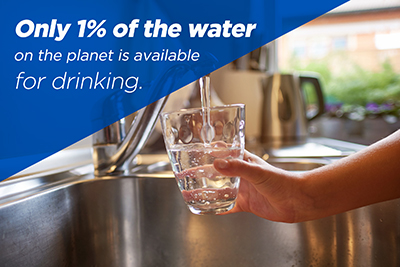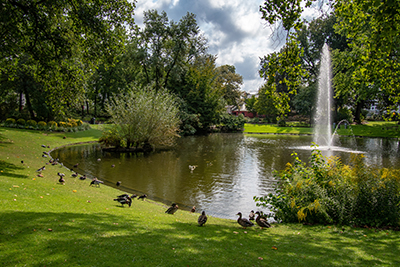Water seems ubiquitous – we turn on the tap, and it’s there.
However, less than two percent of water on the planet is freshwater, and only 1 percent is available as drinking water – the rest is frozen. The United Nations predicts that two-thirds of the world population will be water-stressed by 2025.
The U.S. uses 322 billion gallons of water each day, with 39 billion gallons processed for drinking, and the remainder being used in irrigation and hydroelectric. The average American uses 80 to 100 gallons of water per day. Extensive usage becomes a problem as climate change reduces rain in the western states, which are seeing a population boom, and state water managers in 40 states expect water shortages, according to a Government Accountability Report.
What can local governments do to encourage water conservation? Quite a lot, actually, and here are four things you can do as a local leader to encourage conservation.
Water Conservation Education
Education is one of your least expensive, yet powerful, tools. The Environmental Protection Agency’s WaterSense strives to do for water conservation what ENERGY STAR did for energy efficiency, with an estimated savings of 20 percent less water used when using Water Sense fixtures. The average family can save $380, or roughly 40 percent of their annual water bill, and 13,000 gallons per year when using Water Sense fixtures.
General water saving tips, such as fixing water leaks– which saves up to 20 gallons per day – and washing full loads of laundry and dishes or turning off water while brushing teeth or shaving can be shared on websites and in pamphlets and water bills. When it comes to bills, customers are more likely to understand their consumption and track variations if they are billed in gallons and monthly.
In one study, although respondents agreed that water conservation was important, they didn’t believe they needed to conserve water themselves. However, when they were shown how their water consumption compared to the average consumption in their neighborhood, they were more likely to conserve. Those who were provided with planning worksheets with their bills, helping them set conservation goals and educating them in water-saving strategies, reduced their consumption by nearly 5 percent.
Pricing and Rebates
There are pricing structures designed to encourage conservation. One example is block rate pricing, or increasing the rate of water per unit as consumption increases, which can encourage your customers to conserve to save money. Alternatively a budget-based structure gives each customer a water allocation, based on customer data, customer class and water sources. Other models include time of day pricing – charging higher prices for water used during a utility’s peak demand periods; water surcharges – charging a higher rate for “excessive” water use that exceeds the regional average; and seasonal rates that are adjusted according to weather conditions and the corresponding demand for water.
Some agencies offer rebates to customers for water-saving measures, such as installing low-flow or Water Sense fixtures, pulling up turf lawns or xeriscaping. Depending on the community and its unique needs, rebates can be offered for such items as pool covers, to reduce evaporation, or hot-water circulators. Other municipalities give away low-flow or water-efficient fixtures such as toilets, showerheads and faucet aerators.
Codes, Impact Fees and Service Connections
Retrofit on resale codes require those either selling or buying older homes with water-gobbling fixtures to install new, water-conserving fixtures. Popular in water-stressed California, these ordinances require fixtures to meet a set standard or be replaced – and homes are inspected to be sure the requirements are met.
Outdoor water use is largely discretionary and may make up one-third to two-thirds of a customer’s water usage. Outdoor water features such as ponds, fountains and irrigation don’t require potable water and are an opportunity to encourage water conservation through municipal code.
Codifying outdoor water conservation can address a variety of issues, including gray water, rainwater harvesting, landscaping and water features. Gray water that hasn’t originated in kitchens or toilets, or rainwater caught in a cistern can be used for gardening or irrigation and municipalities can ensure that it is used safely through codification. While attractive, water features can waste a lot of water, so limiting their size, requiring recirculation and features to prevent leakage or evaporation can help conserve water.
New developments can put a large dent in your water supply, so requiring developers to offset that by paying a water system development charge or offering discounted charges if the development includes water conservation measures can help reduce the impact. Some cities are raising prices to defray infrastructure costs, although there is pushback that this can throttle back growth. However, that’s just what some communities want, and they are establishing moratoriums on service connections to prevent demand from outstripping supply.
Water Recovery
Water recycling takes wastewater and treats or purifies it for either industrial use or human consumption. Polls show that 49 percent of Americans are willing to reuse water, and that figure increases for those who are educated about the treatment process.
Recycled grey water can be used for irrigation, cooling processes, recharging ground water, in homes for flushing toilets, and even, when processed to EPA standards, as potable water. Some utilities, such as the Orange County Water District, have replicated grey water recycling across an entire water system.
Another area of innovation is the harvesting of stormwater for irrigation, by capturing and storing stormwater that would otherwise flow into a municipality’s grey water system. In addition, harvesting rainwater with cisterns for non-potable purposes is as old as civilization itself.
Municipal officials can encourage water recovery by establishing quality standards and guidelines for recycled water and ensuring that current codes, particularly plumbing codes, do not prevent water recycling or place an onerous burden on those trying to build or retrofit homes to recycle water.
NLC Service Line Warranty Program partners with municipalities to educate homeowners and offer affordable protection against potentially costly service line repairs. The Program uses a network of local plumbers who have gone through background and drug screenings. The Program’s 500-seat call centeris staffed 24/7/365 to answer claims calls and dispatch contractors to address homeowners’ emergencies.
The Program is provided at no cost to cities, and partner cities can receive royalties based on participation.
To find out how you can help your residents achieve peace of mind, contact us.



